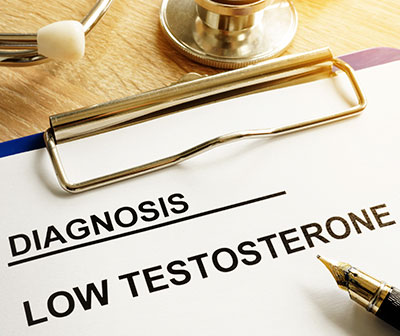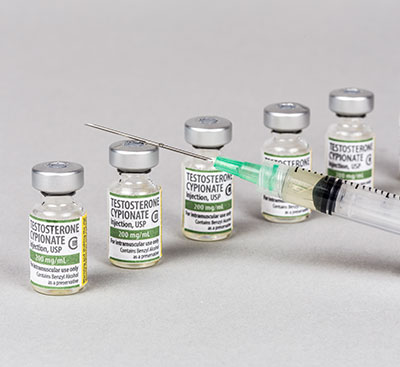Testosterone Deficiency Treatment Guidelines
The medical guidelines say that testosterone replacement therapy is safe and indicated for men diagnosed with testosterone deficiency syndrome.
Testosterone deficiency syndrome, or hypogonadism, or simply "low testosterone," is a condition that occurs when your body is not making adequate supplies of testosterone.
Testosterone is a critical hormone for strength, fat metabolism, muscle and bone health, sexual function, and your overall wellbeing.
What is Testosterone Deficiency?
A testosterone deficiency is defined as your body’s inability to produce enough testosterone. Testosterone is an extremely important hormone for men. As a boy grows into a man, testosterone is critical for the development of male characteristics. Testosterone also has effects on sexual function, fat metabolism, cognitive abilities, and bone and muscle growth and strength.
In men, testosterone is produced in the testes. Any disease, injury, or condition that impacts the function of the testes can lead to a testosterone deficiency. However, the most common cause of low testosterone in men is the normal drop in testosterone levels that occurs as men age.
A man’s testosterone level ramps up at puberty and continues to increase through the teen years, peaking about the age of 20. After that, it starts a steady decline. Once a man is in his 60s, his testosterone level is about half of what it was in his 20s. It is this age-related testosterone deficiency that is the most common testosterone deficiency in men requiring treatment with testosterone replacement therapy.
Doctors describe testosterone deficiencies as either being primary testosterone deficiency or secondary testosterone deficiency. A primary testosterone deficiency is when the testes cannot produce enough testosterone due to a disease, injury, or genetic condition. A secondary testosterone deficiency is when there is a problem in the area of the brain that stimulates the testes to produce and release testosterone.
Primary and secondary testosterone deficiencies can and often do occur together.
A testosterone deficiency is when your body does not produce enough testosterone.
Testosterone Deficiency Diagnosis
Your doctor will test your blood level of testosterone if you have signs or symptoms of hypogonadism or testosterone deficiency.
The signs and symptoms of testosterone deficiency include:
- Lethargy
- Fatigue
- Lack of stamina
- Weight gain
- Slower metabolism
- Weaker bone mineral density
- Loss of lean muscle mass
- Lack of sexual desire
- Erectile dysfunction
- Mental fogginess
- Forgetfulness
- Difficulty with sleeping
- Disturbed sleeping patterns
- Depression, anxiety, and mood swings
- Emotional instability
If you are exhibiting these kinds of symptoms – particularly if you are a man between the ages of 40 and 65 – there is a good chance that low testosterone can be the cause. However, the only way to be sure is to have your testosterone level tested.
In addition to your testosterone blood tests, in order to make a proper diagnosis of low testosterone, your doctor will take a complete medical history and rule out any other causes of your symptoms.
How Is Testosterone Deficiency Treated?
The medical guidelines for the treatment of testosterone deficiency syndrome recommend testosterone replacement therapy. According to guidelines for the treatment of testosterone deficiency in men provided by the Endocrine Society:
- The Society recommends making a diagnosis of hypogonadism only in men with symptoms and signs consistent with testosterone deficiency and unequivocally and consistently low serum T concentrations.
- The Society recommends the use of accurate assays for the measurement of total and free testosterone and rigorously derived reference ranges for the interpretation of testosterone levels.
- The Society Recommend confirming the diagnosis by repeating the measurement of morning fasting total T concentrations.
- In men determined to have androgen deficiency, we recommend additional diagnostic evaluation to ascertain the cause of androgen deficiency.
- We recommend against starting T therapy in patients who are planning fertility in the near term or have any of a number of specified conditions.
Medical guidelines suggest that the best testosterone deficiency treatment is prescription testosterone replacement.
Testosterone Treatment Indications and Contraindications
Testosterone replacement is approved for the treatment of testosterone deficiency. Testosterone replacement therapy is generally regarded as safe for the treatment of low testosterone.
According to Guidelines and a Clinical Review by the American Academy of Family Physicians, “All patients should be counseled on the potential risks and benefits before starting therapy. Potential benefits of therapy include increased libido, improved sexual function, improved mood and wellbeing, and increased muscle mass and bone density. The U.S. Food and Drug Administration warns that testosterone therapy may increase the risk of cardiovascular complications.
Other possible risks include rising prostate-specific antigen levels, worsening lower urinary tract symptoms, polycythemia, and increased risk of venous thromboembolism. Patients receiving testosterone therapy should be monitored to ensure testosterone levels rise appropriately, clinical improvement occurs, and no complications develop. Testosterone therapy may also be used to treat hypoactive sexual desire disorder in postmenopausal women and to produce physical male sex characteristics in female-to-male transgender patients.”
Types of Testosterone Treatments
There are several forms of testosterone treatments. Low testosterone treatment can be given as topical gels and creams, subdermal pellets, skin patches, or testosterone injections. Our doctors have found testosterone injections to be the safest and most effective type of low testosterone treatment.
Testosterone injections are prescribed as different “esters.” Each “ester” is simply a different chemical form of testosterone. They differ only in their molecular structure. The most commonly prescribed esters used for the treatment of low testosterone are testosterone enanthate and testosterone cypionate.
How to Start Treatment
You can only receive testosterone deficiency treatment with a doctor’s prescription. If you qualify, you can get a prescription for testosterone treatment by following these five easy steps:
- Step 1 – Fill out an online medical history form – This first step is the only step in the process of getting a prescription for testosterone injections that can be done online. You cannot legally BUY testosterone injections online or without a prescription.
- Step 2 – See a doctor –If your online medical history form indicates that you are a good candidate for testosterone deficiency treatment, the next step is to see your doctor. He or she will discuss your medical history and conduct a complete physical exam.
- Step 3 – Laboratory hormone testing – Once you have completed your physical exam, if your doctor suspects you may have low testosterone, you will be referred to a laboratory to have the testosterone levels in your blood tested.
- Step 4 – You will obtain a prescription for testosterone treatment – If the results of your laboratory tests indicate that your testosterone levels are below normal, your doctor will prescribe a brand and dosage of testosterone injections to suit your needs and lifestyle.
- Step 5 – Your testosterone treatments will be delivered to you – Your prescription for testosterone therapy will be forwarded to one of the pharmacies we work with that specialize in filling prescriptions for testosterone injections. The pharmacy, in turn, will deliver your testosterone treatment supplies right to your home!
Testosterone Treatment Benefits and Side Effects
Testosterone therapy is generally regarded as safe for the treatment of testosterone deficiencies. However, like any drug or medical procedure, testosterone replacement treatment for low testosterone does have some potential side effects.
Though rare, testosterone therapy side effects can include:
- Increased body hair
- Enlarged breasts
- Headache
- Increased anxiety
- Numbness (patches and gels)
- Pain or inflammation of the injection site (injections)
However, most, if not all, of these possible side effects of prescription testosterone are rare, and testosterone therapy is generally regarded as a safe and effective way to treat patients with testosterone deficiency.
What Do the Studies Say About Treating Testosterone Deficiencies?
There have been decades of clinical studies that have lead to the guidelines for prescribing testosterone replacement as a safe and effective treatment for testosterone deficiency.
Perhaps one of the most significant was a recent “meta-analysis” (a study of studies), which concluded, “the present meta-analysis indicated that testosterone replacement therapy improved the quality of life, increased lean body mass and significantly decreased total cholesterol. In addition, this treatment is well-tolerated and safe for men with hypogonadism [low testosterone].”
The latest research also reverses previous thinking and indicates that testosterone replacement therapy, when used to treat testosterone deficiency, does not increase the patient’s risk of heart attack, and in fact, lowers this risk. The study, published in the European Heart Journal, found that increasing the testosterone levels in men with low testosterone who have suffered a heart attack helped to prevent a second heart attack or other cardiovascular issues.
Similarly, it was once believed that testosterone therapy could increase the risk of prostate cancer. However, a definitive study that involved a review of nearly 150,000 patient cases provided strong evidence that if testosterone therapy is prescribed under proper guidelines, it is safe and doesn’t increase the risk of prostate cancer.
In 2018 the results of a long-term study into the benefits of testosterone therapy known as the “Testosterone Trials” were published. The conclusions that were drawn by the Testosterone Trials included:
- Testosterone treatment for older men with low testosterone improved all aspects of sexual function.
- Testosterone treatment for older men with low testosterone improved stamina, as measured by walking distance.
- Testosterone treatment for older men with low testosterone improved mood and depressive symptoms.
- Testosterone treatment for older men with low testosterone markedly increased the volumetric bone mineral density and estimated bone strength.
These are just a small sample of the many clinical trials that have proven the safety, benefits, and effectiveness of testosterone replacement therapy to treat people diagnosed with testosterone deficiency.
Now that you know more about the treatments for testosterone deficiency, why not take a minute to contact us and learn more about how hormone replacement therapy can improve your quality of life?





